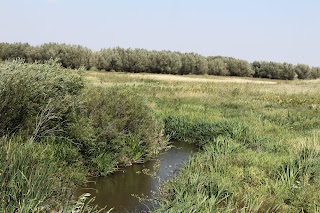 |
| Pine Ridge terrain, northwest Nebraska |
The lack of mountains did not last long. Entering Chadron, I was surprised to see more pine-coverage ridges towering above the plains. The Pine Ridge is not just an random name assigned the nearby Oglala Lakota reservation. Nothing could prepare me for the Pine Ridge escarpment, which separates the White River from the Niobrara River. The looming ridges are as impressive here as they are further south near Scottsbluff and the Wildcat Hills.
No one warned me the same caprock landscape continued north of Scottsbluff, so every few miles brought more gasps at the soaring topography. Nebraska National Forest protects much of these strange, craggy lands, with Nebraska state parks claiming other patches.
There’s almost no traffic other than farm vehicles or the occasionally elderly driver. Pulloffs offer ample views to admire scenery unexpected after miles of preceding farmland. The large mesas and buttes continued to the north, but below them sat Fort Robinson, a U.S. Army post constructed to guard the Red Cloud Agency (later Pine Ridge Reservation) and later supply U.S. forces during the 1870s Indian Wars.
Fort Robinson’s buildings have the look of mid-19th century posts constructed to protect migrants and resupply soldiers in the field. Like most of the region’s military forts from that era, it carries some shameful history.
Crazy Horse was betrayed and died here, traveling to the fort to negotiate a truce, setting up a village nearby. After months of negotiations failed, soldiers went to arrest him, during which he struggled and was fatally wounded by bayonet. A plaque marks where the great warrior, called a “shirt-wearer” by his tribe, fell.
A few years later, the Fort Robinson Massacre of Dull Knife’s band of Northern Cheyenne marked the final battle of the Indian Wars in Nebraska. Fort Robinson remained active until after World War II, and the buildings were spared the wrecking ball as the fort became part of Nebraska’s largest state park, which shares its name.
Here I wanted to stop but drove on, the one major indulgence on the path home still to come. Even on this eye-opening journey through northwest Nebraska, I rationalized by remembering it was a few hours from home. Despite small towns, there were ample camping sites on state and federal land for when I felt like exploring this corner of the panhandle.
Harrison, a small town a few miles from Wyoming and the last settlement for miles in either direction. Billed as “Nebraska’s Top Town,” Harrison fades after a few blocks into farmland and stocky, eroded hills.
I crossed my fingers that I had enough gas to reach Mitchell, since Harrison offer zero options. Twenty miles later, a stand of cottonwoods rose among among the rugged hills and sprawling farms, a sure sign of the region’s water source.
 |
| The mighty Niobrara crosses the monument |
Carnegie and University hills, the crumbling hills overlooking the monument headquarters, were the sites of the excavations of Miocene Epoch fossils from 20 million years ago. Mammal fossils found included ancestors of modern horses, tiny rhinos, bear dogs and more. The monument also protects the site of fossilized corkscrew-shaped burrows of an early land beaver. Although lesser-known than the dinosaurs, these fossils impress on their own merits.
Founded as the Agate Springs Ranch by Cpt. James Cook (not that one) in the 1890s, Cook discovered the bone bed, considered one of the richest sites of Miocene fossils anywhere. The sites were dense with fossils layered upon each other, and kicked off other paleontological discoveries across Nebraska. The glut of fossils in one spot indicates that 20 million years ago, the area housed a watering hole that during periods of drought led to mass die-offs of local fauna. Animals would congregate at the watering hole, eat the surrounding vegetation and gradually expire.
Along with replicas of the original fossils, the visitor center houses the James Cook Collection of Plains Indians artifacts. Cook and Red Cloud became close friends after Cook encountered him on an 1870s cattle drive. Red Cloud’s family and band would take wagon trains to Cook’s ranch, set up tepees and spend weeks hunting and working the land. The collection encompasses gifts made for Cook’s family as well as shirts and pipe bags gifted to Cook. These artifacts form an interesting modern sidebar to the prehistoric wonders reassembled from stone on the Agate ranch’s hills.
I decided to hike out to the twin hills where the fossils were excavated. What seemed like a shallow creek flowed beneath a boardwalk, wetlands hiding it extending hundreds of feet on both banks. This was the Niobrara, shallow and covered, those voluminous wetlands hiding the extent of its waters. I walked the trail alone except for birds zipping through the tall grasses.
Across the two hills, the prairie wind roared. The gusts were fierce in unexpected ways for such a minor elevation change, staggering my steps. Evidence of quarrying for fossils was visible, The feared prairie rattlesnakes stayed in the tall grass, just out of sight, their rattles silent.
 |
| Hills where the Agate bonebeds were excavated |
The urging of the road would not let me gaze for long, not if I wanted to reach the Springs before dark. Ascending into the Wildcat Hills, the last rumple in the landscape until I neared Colorado’s Front Range, I stuck my eyes on the rearview mirror, Scotts Bluff holding steady till I crested that last hill.



No comments:
Post a Comment